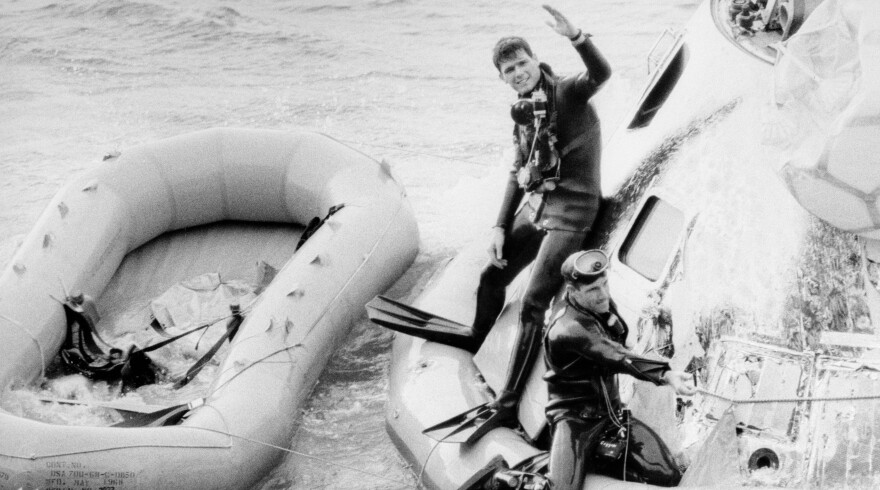
Bob Coggin was just back from serving in Vietnam as a diver in an underwater demolition team when he got his next assignment from the Navy: train to possibly recover Apollo 8. The first manned spacecraft to leave the earth's atmosphere and orbit the moon would soon splash down in the Pacific Ocean.
Coggin understood the importance of the astronauts' mission. But he didn't think much of his own role.
"It was a big deal back then, but we couldn't understand why it was such a big deal," he says. "It was just another day kind of thing really."
The day was December 27, 1968. Coggin's team was one of three poised to secure the space capsule in the predawn hours and assist the astronauts to safety aboard an aircraft carrier, the USS Yorktown.
The then 25 year-old watched from a helicopter, as Apollo 8 seared through the earth's atmosphere, glowing fiery shades of orange and red against a dark sky. It was a mind blowing sight, lasting mere seconds.
"We had cameras around our necks and didn't take the picture because we were so in awe of what we were looking at," says Coggin.
More than 50 years later, Coggin is commissioning a painter to capture the image he still can't shake from his head.
But that morning, there was little time to think. The capsule splashed down near the USS Yorktown. Coggin's helicopter was the closest. His team was it. They would recover Apollo 8 and the astronauts.

"My job was to go out first and jump out of the helicopter into the waiter," he says.
The Navy diver says he swam against 10 foot swells to reach the spacecraft, where he attached a clamp he was carrying to a ring on its side. The other divers jumped out with a flotation collar. Together they inflated it and deployed small parachutes to keep the capsule from spinning or drifting.
Once secure, the astronauts; Frank Borman, James Lovell and William Anders were hoisted by helicopter to safety about the USS Yorktown. They were named Time Magazine's men of the year.
Coggin and his team remained in the water for several more hours.
He lays out pictures and other memorabilia at his Georgetown home, about an hour North of where the USS Yorktown is now on display at Patriot's Point. In one image, Coggin poses with his parents as they welcome him home. He's squeezing his thumb and index finger close together as he describes to them his swim back to the aircraft carrier.
"I was looking down and I could see this little shark way down below," Coggin says. "But he came right on up and he was probably 12 feet."

Coggin says he swam over to the other two divers to warn them they had company. All three tried to signal the helicopter by clapping their hands above their heads. But no one responded.
"The helicopters were thinking that we were just excited and glad it was over," he says. "We were trying to tell them there's some sharks over here, come pick us up."
Coggin says the shark continued to lurk beneath the nets as helicopters eventually picked them up.
"He was probably just curious. He was watching the Apollo mission," Coggin jokes.
The 50th anniversary of the first moon landing with Apollo 11 is July 20th. PBS and American Experience are marking the anniversary with a three part documentary called, "Chasing the Moon". It airs July 8, July 9 and July 10 at 9 p.m. on SCETV.



